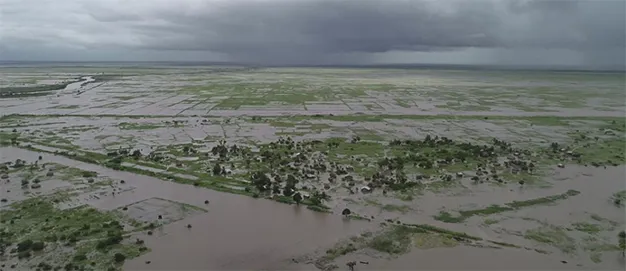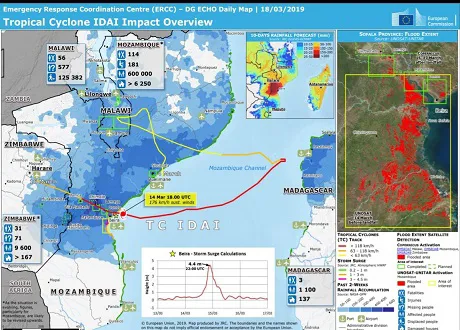Central Mozambique is used to cyclones, but cyclone Idai that made landfall on 14 & 15 March, causing winds of 180+km/h, killing up to a thousand people and displacing tens of thousands in Mozambique, Malawi and Zimbabwe, was something out of the ordinary.
 Floods over Mozambique (photo: World Food Programme)
Floods over Mozambique (photo: World Food Programme)
The death toll is still rising and hundreds of people are still missing or stranded due to wrecked infrastructure as well as floods. The World Food Programme calls it a major humanitarian disaster and the European Union has announced 3.5 million euros and the United Nations $20 million in emergency aid.
 Graphic by the European Commission's Emergency Response Coordination Centre
Graphic by the European Commission's Emergency Response Coordination Centre
Banana production, mango drying not affected
Fortunately banana producers in the south of Mozambique, about 700km removed from the cyclone, were completely unaffected. In fact, says Dr Dries Gouws of Bananaworld, their farms in Boane District (Maputo Province) received not a drop of cyclonic rain last week. This week it has been raining in southern Mozambique, to great relief because it has been in a dry cycle with below average rainfall for the last five years.
Nampula Province in the north of the country, where the TR4 race of Panama disease has devastated banana production, was also left unscathed by the cyclone.
Afrifruta’s drying facility for fruit like mango in Inhambane Province, also southern Mozambique, was fortunately not in the path of the cyclone either, says Ties Minnen, managing director.
Extent to avocado damage in Zimbabwe unclear
Due to damage to telecommunication systems the extent of damage to avocado orchards in Manicaland in the east of Zimbabwe, and specifically in the districts of Chipinge and Chimanimani, is still unclear.
There are reports of over 500mm of rainfall within 24 hours in these parts of Zimbabwe, which brings with it a high risk of avocado's arch-enemy, Phytophthora root rot.
According to 263Chat, a Zimbabwean media organisation, a director of the Tanganda Tea Company said: “Infrastructure that includes roads, bridges and power supply has been destroyed in Chipinge where we operate. Chipinge and Chimanimani are rich agricultural districts housing the big powers of agricultural exports.”
Horticultural producers around Harare were not affected by the cyclone. The main impact for many horticultural producers outside of the devastated areas, in both Zimbabwe and Mozambique, has been transportation: due to damage to roads and bridges, truck drivers have had to find alternative routes.
